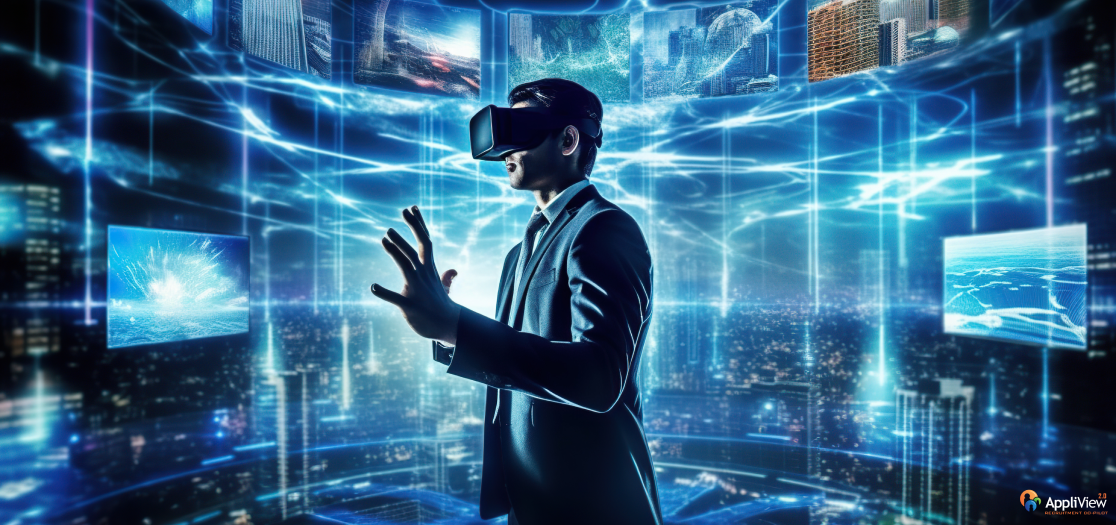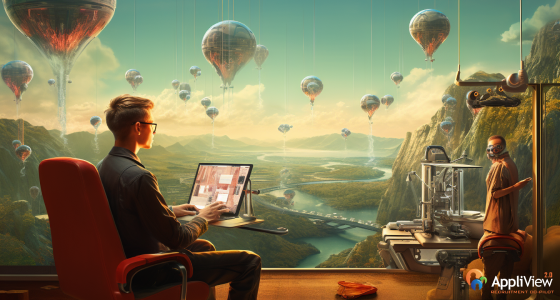Virtual Reality (VR) in HR: Crafting Real-World Experiences in a Virtual Space
December 4, 2023

Virtual Reality (VR) is revolutionizing the HR industry by providing real-world experiences in a virtual environment. This technology has revolutionized recruitment, onboarding, learning, and decision-making processes. It has been used by global corporations to conduct immersive virtual interviews, increasing the pool of available talent and refining skills in healthcare training and development programs. However, implementing VR requires substantial investment in technology and talent, and some employees may resist it. AI-powered analytics, chatbots, recommendation systems, and machine learning algorithms are also enhancing HR processes. VR can be used for employee engagement, allowing for personalized experiences and predictive insights. The combination of VR and AI in HR technology is not just a passing fad but a strategic move to improve HR operations and provide a competitive advantage.
Virtual Reality (VR) in HR: Crafting Real-World Experiences in a Virtual Space
The incorporation of Virtual Reality (VR) has emerged as a transformative force in the ever-changing landscape of Human Resources (HR) technology. This article examines the fascinating realm of virtual reality in human resources, focusing on the creation of real-world experiences within a virtual environment. This investigation will be invaluable to large and medium-sized businesses, as well as entrepreneurs, in search of novel HR solutions.
Introductory Remarks
The HR discipline has come a long way from its traditional, paper-heavy beginnings. It is no longer only about recruiting, firing, and managing employee records; talent management has evolved into a strategic function that aligns with organizational goals. As technology continues to influence this evolution, Virtual Reality (VR) is one of the most exciting frontiers.
The Transformational Trip So Far Evolving HR Environment

The evolution of VR in HR has been nothing short of revolutionary. It is essential to comprehend where this transformation originated and how far it has progressed. The union of virtual reality and human resources is far more than a passing fad; it is an evolution that is rewriting the HR playbook. Historically, HR processes significantly relied on face-to-face interactions, which frequently limited their scope and efficiency. These limitations have been broken by virtual reality, which offers the promise of real-world experiences within a virtual environment.
Success History
The success tales of VR in human resources are astounding. The HR processes of industries that have adopted this technology have seen significant improvements. Global corporations, for instance, are utilizing VR to conduct immersive virtual interviews, allowing them to evaluate candidates from any location. This not only saves time and resources, but also increases the pool of available talent.
VR is revolutionizing healthcare training and development programs. In a risk-free virtual environment, medical professionals can practice surgical procedures, refining their skills and decreasing the likelihood of errors in real-world scenarios. These examples illustrate the immense HR potential of virtual reality.
Advantages and Challenges
Although the benefits of integrating VR into HR are compelling, it is also essential to recognize the obstacles. Positively, VR-driven HR processes can result in increased efficiency, decreased expenses, and enhanced decision-making. Without requiring physical presence, employees can partake in training and development activities, making learning more accessible and adaptable.However, not everything is sailing smoothly. Implementing virtual reality in human resources requires a substantial investment in both technology and talent. Organizations must ensure they possess the necessary infrastructure and knowledge to support these initiatives. In addition, some employees may resist implementing this new technology, necessitating change management initiatives.
Important Areas HR is Being Revolutionized by AI
While Virtual Reality (VR) in HR is a game-changer on its own, its impact is significantly amplified when combined with Artificial Intelligence (AI).
The Integration of VR and AI
Virtual Reality (VR) in Human Resources (HR) is a game-changer in and of itself, but when combined with Artificial Intelligence (AI), its impact is significantly amplified. HR processes are significantly enhanced by AI-powered analytics, chatbots, recommendation systems, and machine learning algorithms.
Virtual Recruitment and Onboarding

Together, AI and VR are redefining the recruiting process in the field of recruitment. The immersive environment that virtual reality provides for interviews and assessments allows for a more thorough evaluation of candidates. Chatbots powered by AI can manage initial candidate interactions, schedule interviews, and even aid in the recruiting process. This not only saves time but also ensures that all candidates have a consistent and fair experience.
Learning and Progress
In the field of learning and development, VR and AI are transforming training programs. Employees can practice and acquire knowledge in a risk-free environment through the use of VR simulations. Algorithms based on artificial intelligence monitor and analyze employee performance, adapting training content to individual requirements. This leads to more productive and efficient learning experiences.The data analysis abilities of AI are a boon for human resource professionals. AI assists with data-driven decision making by collecting and analyzing vast quantities of data. This is complemented by VR’s immersive and interactive data visualization, which makes it simpler for HR teams to identify trends, issues, and opportunities.
Forecasts of the Future
The integration of Virtual Reality (VR) and Artificial Intelligence (AI) in HR technology is poised to lead the way into the future. Here are some forecasts regarding the future of these HR technologies:
Optimized Candidate Experience
The experience of candidates will be transformed. Interviews and assessments will be conducted in a more immersive and interactive manner using virtual reality. AI algorithms will guarantee that candidates receive individualized suggestions and feedback. The outcome? A more positive and engaging experience for prospective candidates.
Remote Work and Collaboration
VR will facilitate virtual team meetings and collaboration in shared virtual spaces as remote work becomes more prevalent. AI will make remote work more efficient by providing intelligent scheduling, automated task assignment, and real-time performance analytics.
Individualized Learning Pathways
Learning and growth will become highly individualized. AI will curate learning content based on employee performance and career objectives, while VR simulations will adapt to individual learning styles. This will result in greater skill development efficiency.HR data visualization will become more immersive and informative.
Employee Wellness Search Terms
The wellbeing of employees will obtain a substantial boost. VR can provide stress-relieving experiences and wellness programs, while AI will monitor employee well-being and suggest appropriate interventions. This comprehensive strategy will result in healthier and happier employees. As we look into the future, it is evident that the combination of VR and AI in HR will continue to revolutionize the HR landscape. These technologies are more than just instruments; they are strategic partners that assist businesses in attracting, engaging, and retaining top talent.
The conclusion
In the ever-changing realm of HR technology, Virtual Reality (VR) and Artificial Intelligence (AI) have proved instrumental in the creation of real-world experiences within a virtual environment. This transformational journey has already begun, and its implications are limitless. Embracing virtual reality (VR) and artificial intelligence (AI) is a strategic move for large and medium-sized businesses, as well as entrepreneurs, that wish to maintain competitiveness and improve their HR strategies.
